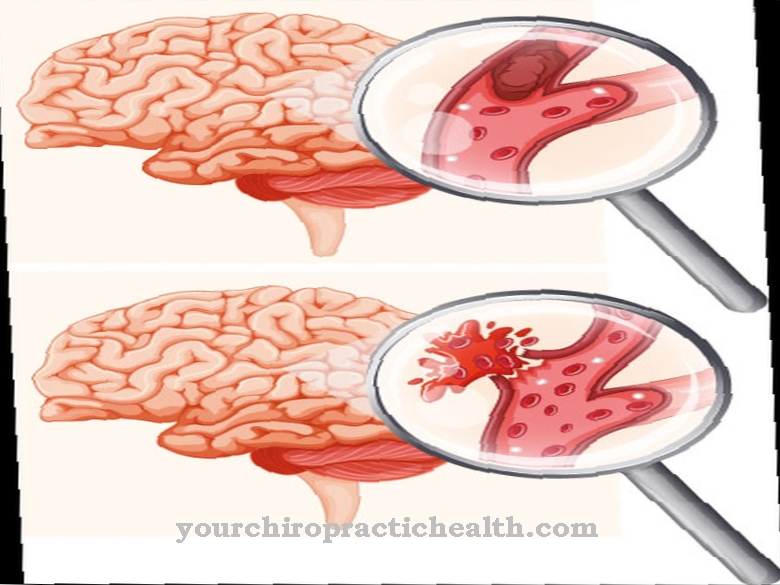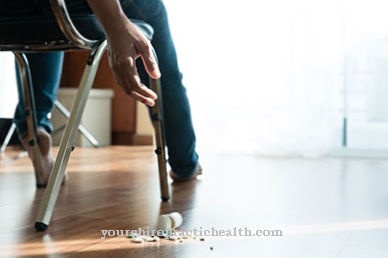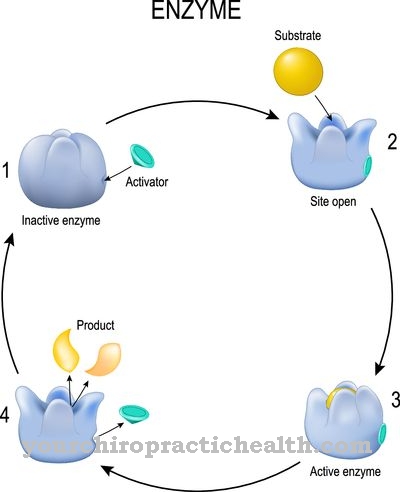At the Albinism a genetic effect results in a deficiency or complete absence of melanin. Melanin is responsible, among other things, for the formation of pigments in the skin, eyes and hair. Albinism, which not only occurs in humans, can become an outwardly very noticeable disease. Affected people are often referred to as albinos, but for many patients this represents lead or discrimination.
What is albinism?

Albinism is one of the hereditary diseases that can also be passed on from parents with normal pigmentation, as the genetic defect is recessive - that is, receding. It manifests itself in a lack of or only limited production of the pigment melanin.
Albinism is divided into several groups. One main group is ocular albinism, in which only the eyes and thus also the ability to see are affected. The other main group is oculocutaneous albinism, which is best known in public for having light to white hair and light skin.
In both variants, those affected suffer from moderate to severe impairment of their vision. In oculocutaneous albinism, there is an increased risk of skin cancer from exposure to sunlight due to the lack of pigmentation of the skin.
causes
Albinism is caused by the inability of the cells responsible for dye production to produce melanin. There is a lack of crucial enzymes to get this production going or to operate it to a sufficient extent.
This deficiency is due to a genetic defect, but it has been linked to different genes and chromosomes. All of them have an influence on a decisive process in the formation of melanin. In addition, albinism occurs in connection with other genetic defects, including the now better known Prader-Willi syndrome. In ocular albinism, the cause of the visual difficulties is also the lack of melanin.
In addition to the color formation of the iris, this is also responsible for the fact that the fundus lacks the necessary melanin, there is noticeable tremor and the optic nerves of people suffering from albinism are not fully developed.
You can find your medication here
➔ Medicines for pale skinSymptoms, ailments & signs
The symptoms and symptoms of albinism are usually relatively clear. However, they do not lead to decreased health or other serious conditions, so that most patients do not suffer from a reduced life expectancy. Those affected primarily show pigmentation disorders in albinism.
The skin can also be completely white or even matt and pale in color. In most cases, the color of the skin does not change even when exposed to sunlight. Albinism often also affects the patient's hair, so that it appears white, dull or yellowish. There is also ametropia, so that those affected are either nearsighted or farsighted.
Furthermore, albinism does not lead to further complications or symptoms. However, the high sensitivity of the skin to sunlight also increases the risk of skin cancer enormously, so that those affected depend on regular examinations. The extent of albinism can also be very different, so that not all symptoms have to appear together. The illness can also lead to psychological complaints or depression, as the patients are often disregarded because of their appearance or, above all, bullied at school.
Diagnosis & course
In the case of pronounced albinism, the diagnosis is initially a simple visual diagnosis. Even in babies, the light skin is just as noticeable as the colorless hair. Contrary to popular belief, the color of the eyes is not fundamentally red. Mostly there is a light blue. Only in fully developed albinism does the iris lack pigmentation.
During the examination, the pediatrician determines a transparent iris in which the veins can be clearly seen as a reddish shimmer. The diagnosis is confirmed by a genetic test. The lack of pigmentation on the skin requires special care in sunlight from the start. People with albinism do not have pigment protection for their skin and live with an increased risk of skin cancer.
Complications
Albinism can be more or less pronounced. In some, only the pigmentation of the eye is affected, which is referred to as ocular albinism. The color of the skin and hair is normal. However, the lack of pigmentation in the eyes leads to a wide variety of eye problems, such as strabismus or sensitivity to light.
In extreme cases, the entire melanin production is defective, as a result, those affected have white hair, extremely pale skin and unusually light eyes that are very sensitive to light. In technical jargon, this is called oculocutaneous albinism (OCA), that is, albinism that affects both the eyes and the skin. Depending on the severity, a distinction is made between different subtypes - from OCA 1 a / b to OCA 4.
In very rare cases, those affected not only suffer from a lack of pigmentation, but also from a higher risk of infection, neurological problems or lung, bowel and bleeding disorders. However, these cases are extremely rare. Those affected can find detailed information on the subject of albinism on the website of the non-profit online self-help group "NOAH".
When should you go to the doctor?
Albinism is diagnosed at birth and should be examined by a doctor immediately. During the initial examination of an affected newborn, the doctor will pay particular attention to the development of physical functions that may be impaired by albinism. Of course, it is also possible that a child with albinism may only later find out that they have physical problems.
It is important that the parents of such a child inform themselves about the symptoms by which they would recognize that their child should be examined by a doctor. For example, if you have problems with your eyesight, this is normal for albinism, but should be treated immediately. Many people live with albinism without major problems or congenital and acquired disorders, but face different risks and challenges. This particularly applies to the skin's sensitivity to light.
If people with albinism notice any visible changes in the skin such as redness, pain or raised areas, they should see a dermatologist sooner rather than later. Due to its high susceptibility to damage from UV radiation, albinism carries an increased risk of skin cancer.
For forms of albinism that cause significant problems up to physical and mental disabilities, regular medical appointments must be made. These are used to monitor the health of the person concerned and to identify further problems in good time. In the case of severe disabilities, accommodation in a home with trained nurses can make sense.
Doctors & therapists in your area
Treatment & Therapy
A cure for albinism is not possible. But the defect is not life-shortening. Due to the increased risk of skin cancer, a comprehensive examination for skin abnormalities should be carried out regularly.
The impaired vision is more stressful for those affected by albinism. Their eyesight is poor, which in severe cases can be as low as 10 percent. Visual aids are indispensable and make it easier to cope with everyday life. Most people suffering from albinism cannot or are not allowed to drive because they cannot safely see even larger objects.
In addition to physical aids, psychological support is recommended in some cases if the person concerned suffers from his or her unusual appearance. In some cultures, especially on the African continent, the appearance of albinism is associated with social exclusion. Traditionally, in many regions there, people suffering from albinism are considered a bad omen or cursed.
This devaluation has not been able to develop to this extent in Western cultures, as people with albinism are rarely noticed in this degree of clarity among fair-skinned Western Europeans.
Outlook & forecast
In most cases, albinism itself does not lead to particular health restrictions or complaints. However, albinism can lead to considerable psychological complaints due to discrimination. Children in particular can become victims of bullying or teasing, which can lead to significant psychological complaints or depression.
Those affected suffer from very white and pale skin and pigment disorders. These can occur on the entire body, but do not pose any particular health risk to the patient. The hair is also usually white. Furthermore, those affected suffer from an increased sensitivity to light and discomfort to the eyes.
It comes mainly to farsightedness or nearsightedness. These complaints can, however, be compensated for by wearing glasses or contact lenses. As a rule, albinism also leads to an increased risk of various infections and inflammations.
Treatment of albinism is not possible. However, those affected often need psychological support. Life expectancy in patients with albinism is not reduced and their everyday life is at least not restricted by the disease itself. Furthermore, there are no particular complaints or complications. However, albinism can also increase the patient's risk of skin cancer.
You can find your medication here
➔ Medicines for pale skinprevention
It is not possible to prevent albinism as a typical hereditary disease. Except for the visual impairment, the occurrence of this genetic defect is not associated with severe restrictions for those affected. Those affected must, however, observe the protective measures against sunlight in order to avoid cancer in a disciplined manner so that albinism cannot show any health-threatening effects.
Aftercare
The aftercare should, among other things, ensure that an illness does not recur. However, since albinism cannot be cured, this cannot be the aim of medical monitoring. Rather, it is about preventing complications and supporting patients in their everyday lives. Those affected contact a doctor in the event of acute symptoms.
Regular examination is rare. Those affected receive extensive information about the effects of the disease upon initial diagnosis. Albinism does not reduce lifespan. The main preventive measures include skin protection. The largest human body organ is exposed to UV rays with almost no protection.
Patients must avoid direct sunlight. The strong midday heat brings the greatest risk. Sun creams with a high sun protection factor should be used. Sometimes those suffering from the defect also suffer from poor eyesight. Glasses can help. The white and pale skin is characteristic. It sometimes requires psychological follow-up.
Children and adolescents in particular regularly find being different to be stressful. They are not infrequently exposed to the gossip of their peers. Sometimes those affected complain of disadvantages in the workplace. A doctor can order psychotherapy. This can prevent depression and anxiety disorders.
You can do that yourself
Albinism is a disease that cannot be cured as it is due to a genetic defect, it is a hereditary disease. Therefore, the person affected has to live with albinism and adjust their everyday life to their special needs.
Sunbathing should be strictly avoided because the lack of melanin in the skin and sometimes in the iris of the eyes can quickly burn the skin. In general, the hours of sunshine should be avoided, especially in summer.
When leaving the house, the person concerned must ensure that they wear a hat and clothing that can protect them from the harmful UV rays of the sun. The eyes of patients with albinism are particularly sensitive to the sun if they are affected by the hereditary disease. Wearing sunglasses is therefore essential.
Albinism varies in severity, so the patient must respond to his or her special needs and discuss them with a doctor. The vision of patients with albinism is often severely impaired, so a visual aid, e.g. glasses. In addition, patients are often not allowed to drive because of their poor eyesight. You are therefore dependent on public transport or friends and family to do everyday things.





.jpg)





















